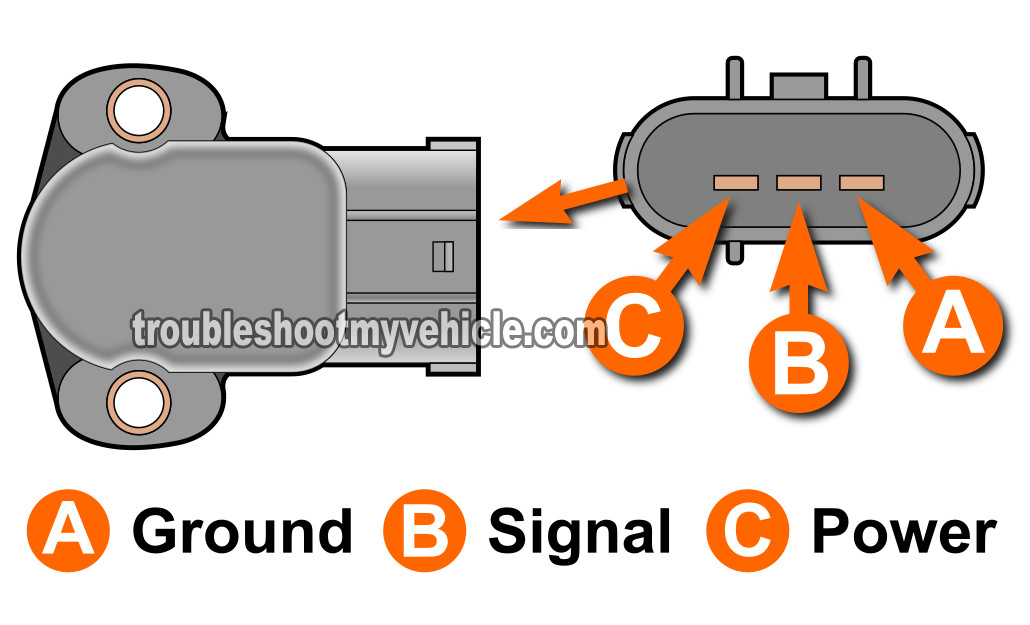
The throttle position sensor (TPS for short) on your 3.0L Ford Ranger (3.0L Mazda B3000) produces an analog voltage signal as you step on or off the accelerator pedal. This voltage signal can easily be read with a multimeter. In this tutorial I'll show you how and in the process, you'll find out if the TPS is good or has failed.
This is a pretty easy and simple test. I'll explain it all in a step-by-step way.
Contents of this tutorial:
NOTE: This tutorial applies to specific 3.0L Ford Vehicles. Take a look at the Applies To: box on the right column to check application.
![]() You can find this tutorial in Spanish here: Cómo Probar El Sensor TPS (1995-1998 3.0L Ford Ranger) (at: autotecnico-online.com).
You can find this tutorial in Spanish here: Cómo Probar El Sensor TPS (1995-1998 3.0L Ford Ranger) (at: autotecnico-online.com).
Symptoms Of A Bad Throttle Position Sensor
The voltage signal, that the TPS creates, tells the fuel injection computer the exact position of the throttle plate. This information is used, among many things, to: inject more fuel, advance ignition timing, etc.
Since the TPS is such a critical role in your 3.0L Ranger's engine management system, when it fails you'll see or more of the following symptoms:
- If your 3.0L Ranger (3.0L B3000) is OBD II equipped (1996+), you'll see one of the following trouble codes:
- P0120: Throttle Position Sensor Circuit.
- P0121: Throttle Position Sensor Circuit.
- If your 3.0L Ford Ranger is OBD I equipped, you'll see one of the following trouble codes:
- 41: Throttle Position Sensor Signal.
- Hesitation when accelerating the engine.
- Lack of power.
- Bad gas mileage.
Circuit Descriptions Of The TPS

The table below has a brief description of the 3 wires that make up the TPS connector.
| TPS Circuits (1995-1998 3.0L Ford Ranger) | ||
|---|---|---|
| Terminal | Wire | Description |
| A | GRY/RED | Sensor Ground |
| B | GRY/WHT | TP Signal |
| C | BRN/WHT | Power (5 Volts DC) |
NOTE: The above circuit descriptions apply only to the 1995-1998 3.0L Ford Ranger and 1995-1996 3.0L Mazda B3000 throttle position sensor.
Where To Buy The TPS And Save
The following links will help you to comparison shop for a new 3.0L Ranger TPS. I think they'll save you a few bucks:
Disclosure: As an Amazon Associate, I earn from qualifying purchases. If my tutorials help you, using these links is an easy way to support the site at no extra cost to you. Thank you!
Not sure if the above TPS fits your particular 3.0L Ford Ranger? Don't worry, once you get to the site they'll make sure it fits by asking you the specifics of your particular Ford vehicle. If it doesn't fit, they'll find you the right one.
TEST 1: Testing The TPS Voltage Signal

To find out if the TPS is bad (or not), we need to read its throttle angle voltage signal. This entails tapping into the TP sensor's middle wire and reading the voltage signal as we manually open and close the throttle plate. This is done with the Key On but Engine Off (KOEO).
If the TPS is working correctly, this throttle angle voltage signal will increase as we open the throttle plate and decrease as we close it.
If the TP sensor has failed, its throttle angle voltage signal will stay stuck in one voltage value no matter how much we open or close the throttle plate.
Alright, let's get started:
- 1
Turn the key to the ON position but don't start the engine, and place your multimeter in Volts DC mode.
- 2
Connect the red multimeter test lead to the gray with white stripe (or GRY/WHT) wire. This is the wire that connects to TPS male spade terminal identified with the letter B in the illustration above.
- 3
Ground the black multimeter test lead on the battery negative (-) terminal.
- 4
Your multimeter should report a voltage between 0.2 to 0.9 Volts DC with the throttle plate closed. If your multimeter doesn't, don't worry about it just yet, continue with the other steps.
- 5
Slowly open the throttle (by hand and from the engine compartment). The voltage numbers should increase as the throttle plate opens.
This increase in voltage should be smooth and without any gaps or skips. Once the throttle is wide open, your multimeter should read somewhere between 3.5 to 4.5 Volts DC. - 6
Slowly close the throttle. As the throttle is closing, you should see the voltage decrease smoothly and without any gaps or skips, to the exact same voltage you noticed in step 3.
- 7
Lightly tap on the throttle position sensor with the handle of a screw-driver (or something similar, and I want to emphasize the words ‘lightly tap’) as you slowly open and close the throttle and observe the multimeter.
If the TPS is bad, the tapping will cause the voltage numbers to skip or go blank. If the TPS is OK, the tapping will have no effect on the voltage numbers. - 8
Repeat step 7 several times to make sure of your multimeter test results.
Let's take a look at your test results:
CASE 1: The throttle angle voltage increased and decreased as you opened and closed the throttle plate. This is the correct test result. It tells you that the TPS, on your 3.0L Ford Ranger (3.0L Mazda B3000) IS NOT defective.
This test result also confirms that the TPS is getting both power and Ground from your Ranger's fuel injection computer.
CASE 2: The throttle angle voltage DID NOT increase (or decrease) as you opened and closed the throttle plate. This test result usually tells you that the TPS, on your 3.0L Ford Ranger, is bad.
To be absolutely sure the TPS is bad, I recommend that you make sure that it's getting both power and Ground. Your next step is to go to: TEST 2: Verifying Throttle Position Sensor Has 5 Volts And Ground.
CASE 3: The multimeter DID NOT register any voltage. This test result doesn't condemn the TP sensor as bad just yet.
Why? Because the TP sensor may be missing either power or Ground. So the next step is to check that the TP sensor is getting power and Ground, go to: TEST 2: Verifying Throttle Position Sensor Has 5 Volts And Ground.




